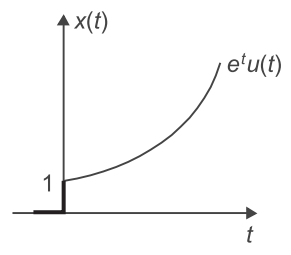Signal and systems miscellaneous
- Let x[n] = anu[n] h[n] = bnu[n] What is the expression for y[n], for a discrete-time system?
-
View Hint View Answer Discuss in Forum
For any arbitrary signal x(n) the response of the system is given by
∞ y(n) = ∑ x(k).x(n – k) k = – ∞
Here, x(n) = an.u(n)
x(n) = bn u(n)∞ So, y(n) = ∑ ak u(k).bn – k u[n – k] k = – ∞
Hence, alternative (A) is the correct answer.Correct Option: A
For any arbitrary signal x(n) the response of the system is given by
∞ y(n) = ∑ x(k).x(n – k) k = – ∞
Here, x(n) = an.u(n)
x(n) = bn u(n)∞ So, y(n) = ∑ ak u(k).bn – k u[n – k] k = – ∞
Hence, alternative (A) is the correct answer.
- For the signal shown below—

-
View Hint View Answer Discuss in Forum
NA
Correct Option: B
NA
- The output y[n] of a discrete time LTI system is related to the input x(n) as given below:
∞ y(n) = ∑ x(k) k = 0
Which one of the following correctly relates the z-transform of the input and output, denoted by x(z) and y(z), respectively?
-
View Hint View Answer Discuss in Forum
Given,
∞ y(n) = ∑ x(k) k = 0
which represents an accumulator, whose z-transform isY(z) = z · X(z) z – 1 or Y(z) = X(z) 1 – z– 1
Hence, alternative (C) is the correct choice.Correct Option: C
Given,
∞ y(n) = ∑ x(k) k = 0
which represents an accumulator, whose z-transform isY(z) = z · X(z) z – 1 or Y(z) = X(z) 1 – z– 1
Hence, alternative (C) is the correct choice.
- The Laplace transform of the function—
f(t) = t3 + 3t2 – 6t + 4
-
View Hint View Answer Discuss in Forum
L{f(t)} = L{t3 + 3t2 – 6t + 4}
= 3! + 3·2! – 6·1! + 4 s4 s3 s2 s = 3·2·1 + 3·2·1 – 6·1 + 4 s4 s3 s2 s = 6 + 6 – 6 + 4 s4 s3 s2 s
Hence, alternative (B) is the correct answer.Correct Option: B
L{f(t)} = L{t3 + 3t2 – 6t + 4}
= 3! + 3·2! – 6·1! + 4 s4 s3 s2 s = 3·2·1 + 3·2·1 – 6·1 + 4 s4 s3 s2 s = 6 + 6 – 6 + 4 s4 s3 s2 s
Hence, alternative (B) is the correct answer.
- Which of the following is the inverse z-transform of
X(z) = z |z| < 2 (z – 2) (z – 3)
-
View Hint View Answer Discuss in Forum
Given that
X(z) = z |z| < 2 (z – 2) (z – 3) or X(z) = A + A z z – 2 z – 3 or X(z) = -1 + 1 z z – 2 z – 3 or X(z) = – 
z 
+ 
z 
z – 2 z – 3 or X(z) = – 
1 
+ 
1 
1 – 2z– 1 1 – 3z– 1
Now, since in the region |z| < 2 both the poles are exterior i.e., anti-causal and hence inverse z-transform.
x(n) = [– (– 2n) + (– 3n)] u(– n – 1)
or x(n) = (2n – 3n) u(– n – 1)
Hence, alternative (A) is the correct choice.
Correct Option: A
Given that
X(z) = z |z| < 2 (z – 2) (z – 3) or X(z) = A + A z z – 2 z – 3 or X(z) = -1 + 1 z z – 2 z – 3 or X(z) = – 
z 
+ 
z 
z – 2 z – 3 or X(z) = – 
1 
+ 
1 
1 – 2z– 1 1 – 3z– 1
Now, since in the region |z| < 2 both the poles are exterior i.e., anti-causal and hence inverse z-transform.
x(n) = [– (– 2n) + (– 3n)] u(– n – 1)
or x(n) = (2n – 3n) u(– n – 1)
Hence, alternative (A) is the correct choice.

